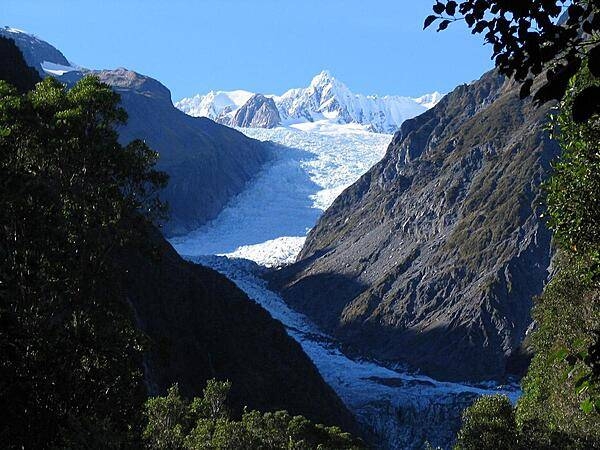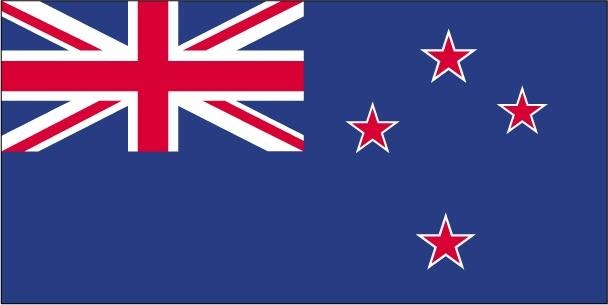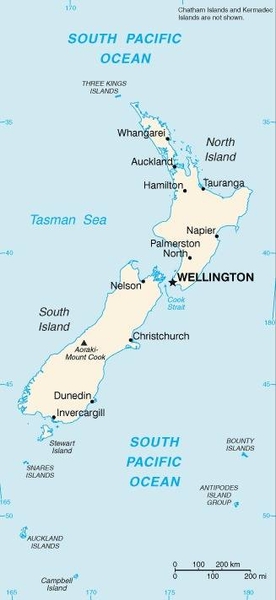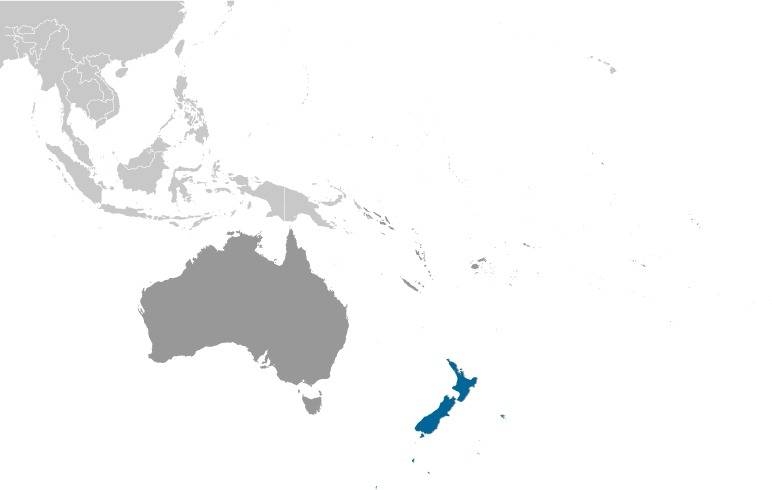New Zealand
Introduction
Background
Polynesian settlers may have arrived in New Zealand in the late 1200s, with widespread settlement in the mid-1300s. They called the land Aotearoa, which legend holds is the name of the canoe that Kupe, the first Polynesian in New Zealand, used to sail to the country; the name Aotearoa is now in widespread use as the local Maori name for the country. Competition for land and resources led to intermittent fighting between different Maori iwi (tribes) by the 1500s as large game became extinct. Dutch explorer Abel TASMAN was the first European to see the islands in 1642 but after an encounter with local Maori, he sailed away. British captain James COOK was the next European to arrive in New Zealand in 1769, followed by whalers, sealers, and traders. The UK only nominally claimed New Zealand and included it as part of New South Wales in Australia. Concerns about increasing lawlessness led the UK to appoint its first British Resident in New Zealand in 1832, although he had few legal powers. In 1835, some Maori iwi from the North Island declared independence as the United Tribes of New Zealand. Fearing an impending French settlement and takeover, they asked the British for protection. In 1840, the British negotiated their protection in the Treaty of Waitangi, which was eventually signed by more than 500 different Maori chiefs, although many chiefs did not or were not asked to sign. In the English-language version of the treaty, the British thought the Maori ceded their land to the UK, but translations of the treaty appeared to give the British less authority, and land tenure issues stemming from the treaty are still present and being actively negotiated in New Zealand.
The UK declared New Zealand a separate colony in 1841 and gave it limited self-government in 1852. Different traditions of authority and land use led to a series of wars from the 1840s to the 1870s fought between Europeans and various Maori iwi. Along with disease, these conflicts halved the Maori population. In the 1890s, New Zealand initially expressed interest in joining independence talks with Australia but ultimately opted against it and changed its status to an independent dominion in 1907. New Zealand provided more than 100,000 troops during each World War, many of whom fought as part of the Australia and New Zealand Army Corps (ANZAC). New Zealand reaffirmed its independence in 1947, signed the Australia, New Zealand, and US (ANZUS) Treaty, and militarily supported the US in the Korean and Vietnam Wars. Beginning in 1984, New Zealand began to adopt nuclear-free policies, contributing to a dispute with the US over naval ship visits that led the US to suspend its defense obligations to New Zealand in 1986.
In recent years, New Zealand has explored reducing some of its ties to the UK. There in an active, minority movement about changing New Zealand to a republic, and in 2015-16, a referendum on changing the New Zealand flag to remove the Union Jack failed 57% to 43%.
Visit the Definitions and Notes page to view a description of each topic.
Geography
Location
Oceania, islands in the South Pacific Ocean, southeast of Australia
Geographic coordinates
41 00 S, 174 00 E
Map references
Oceania
Area
total: 268,838 sq km
land: 264,537 sq km
water: 4,301 sq km
note: includes Antipodes Islands, Auckland Islands, Bounty Islands, Campbell Island, Chatham Islands, and Kermadec Islands
Area - comparative
almost twice the size of North Carolina; about the size of Colorado
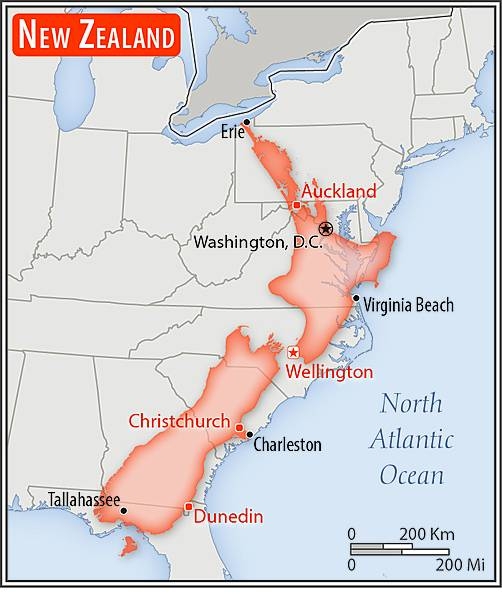
Land boundaries
total: 0 km
Coastline
15,134 km
Maritime claims
territorial sea: 12 nm
contiguous zone: 24 nm
exclusive economic zone: 200 nm
continental shelf: 200 nm or to the edge of the continental margin
Climate
temperate with sharp regional contrasts
Terrain
predominately mountainous with large coastal plains
Elevation
highest point: Aoraki/Mount Cook 3,724 m; note - the mountain's height was 3,764 m until 14 December 1991 when it lost about 10 m in an avalanche of rock and ice; erosion of the ice cap since then has brought the height down another 30 m
lowest point: Pacific Ocean 0 m
mean elevation: 388 m
Natural resources
natural gas, iron ore, sand, coal, timber, hydropower, gold, limestone
Land use
agricultural land: 43.2% (2018 est.)
arable land: 1.8% (2018 est.)
permanent crops: 0.3% (2018 est.)
permanent pasture: 41.1% (2018 est.)
forest: 31.4% (2018 est.)
other: 25.4% (2018 est.)
Irrigated land
7,000 sq km (2014)
Major lakes (area sq km)
fresh water lake(s): Lake Taupo - 610 sq km
Population distribution
over three-quarters of New Zealanders, including the indigenous Maori, live on the North Island, primarily in urban areas
Natural hazards
earthquakes are common, though usually not severe; volcanic activity
volcanism: significant volcanism on North Island; Ruapehu (2,797 m), which last erupted in 2007, has a history of large eruptions in the past century; Taranaki has the potential to produce dangerous avalanches and lahars; other historically active volcanoes include Okataina, Raoul Island, Tongariro, and White Island; see note 2 under "Geography - note"
Geography - note
note 1: consists of two main islands and a number of smaller islands; South Island, the larger main island, is the 12th largest island in the world and is divided along its length by the Southern Alps; North Island is the 14th largest island in the world and is not as mountainous, but it is marked by volcanism
note 2: New Zealand lies along the Ring of Fire, a belt of active volcanoes and earthquake epicenters bordering the Pacific Ocean; up to 90% of the world's earthquakes and some 75% of the world's volcanoes occur within the Ring of Fire
note 3: almost 90% of the population lives in cities and over three-quarters on North Island; Wellington is the southernmost national capital in the world
People and Society
Nationality
noun: New Zealander(s)
adjective: New Zealand
Ethnic groups
European 64.1%, Maori 16.5%, Chinese 4.9%, Indian 4.7%, Samoan 3.9%, Tongan 1.8%, Cook Islands Maori 1.7%, English 1.5%, Filipino 1.5%, New Zealander 1%, other 13.7% (2018 est.)
note: based on the 2018 census of the usually resident population; percentages add up to more than 100% because respondents were able to identify more than one ethnic group
Languages
English (de facto official) 95.4%, Maori (de jure official) 4%, Samoan 2.2%, Northern Chinese 2%, Hindi 1.5%, French 1.2%, Yue 1.1%, New Zealand Sign Language (de jure official) 0.5%, other or not stated 17.2% (2018 est.)
note: shares sum to 124.1% due to multiple responses on the 2018 census
Religions
Christian 37.3% (Catholic 10.1%, Anglican 6.8%, Presbyterian and Congregational 5.2%, Pentecostal 1.8%, Methodist 1.6%, Church of Jesus Christ 1.2%, other 10.7%), Hindu 2.7%, Maori 1.3%, Muslim, 1.3%, Buddhist 1.1%, other religion 1.6% (includes Judaism, Spiritualism and New Age religions, Baha'i, Asian religions other than Buddhism), no religion 48.6%, objected to answering 6.7% (2018 est.)
note: based on the 2018 census of the usually resident population; percentages add up to more than 100% because respondents were able to identify more than one religion
Age structure
0-14 years: 19.63% (male 496,802/female 469,853)
15-24 years: 12.92% (male 328,327/female 308,132)
25-54 years: 39.98% (male 996,857/female 972,566)
55-64 years: 11.93% (male 285,989/female 301,692)
65 years and over: 15.54% (male 358,228/female 407,031) (2020 est.)
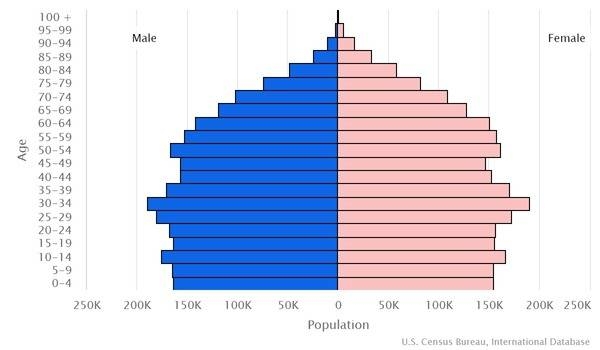
Dependency ratios
total dependency ratio: 53.4
youth dependency ratio: 29
elderly dependency ratio: 24.4
potential support ratio: 4.1 (2021 est.)
Median age
total: 37.2 years
male: 36.4 years
female: 37.9 years (2020 est.)
Population distribution
over three-quarters of New Zealanders, including the indigenous Maori, live on the North Island, primarily in urban areas
Urbanization
urban population: 87% of total population (2023)
rate of urbanization: 0.92% annual rate of change (2020-25 est.)
Major urban areas - population
1.673 million Auckland, 422,000 WELLINGTON (capital) (2023)
Sex ratio
at birth: 1.05 male(s)/female
0-14 years: 1.06 male(s)/female
15-24 years: 1.06 male(s)/female
25-54 years: 1.03 male(s)/female
55-64 years: 0.95 male(s)/female
65 years and over: 0.76 male(s)/female
total population: 1 male(s)/female (2022 est.)
Mother's mean age at first birth
27.8 years
Maternal mortality ratio
9 deaths/100,000 live births (2017 est.)
country comparison to the world: 148Infant mortality rate
total: 3.44 deaths/1,000 live births
male: 3.64 deaths/1,000 live births
female: 3.23 deaths/1,000 live births (2022 est.)
Life expectancy at birth
total population: 82.54 years
male: 80.78 years
female: 84.39 years (2022 est.)
Contraceptive prevalence rate
79.9% (2014/15)
note: percent of women aged 16-49
Drinking water source
improved: urban: 100% of population
rural: 100% of population
total: 100% of population
unimproved: urban: 0% of population
rural: 0% of population
total: 0% of population (2020 est.)
Current health expenditure
9.7% of GDP (2019)
Physicians density
3.62 physicians/1,000 population (2020)
Hospital bed density
2.6 beds/1,000 population (2019)
Sanitation facility access
improved: urban: 100% of population
rural: 100% of population
total: 100% of population
unimproved: urban: 0% of population
rural: 0% of population
total: 0% of population (2020)
HIV/AIDS - adult prevalence rate
(2021 est.) <0.1%
Alcohol consumption per capita
total: 9.17 liters of pure alcohol (2019 est.)
beer: 3.41 liters of pure alcohol (2019 est.)
wine: 2.88 liters of pure alcohol (2019 est.)
spirits: 1.62 liters of pure alcohol (2019 est.)
other alcohols: 1.26 liters of pure alcohol (2019 est.)
Tobacco use
total: 13.7% (2020 est.)
male: 15% (2020 est.)
female: 12.3% (2020 est.)
Literacy
total population: NA
male: NA
female: NA
School life expectancy (primary to tertiary education)
total: 20 years
male: 20 years
female: 21 years (2020)
Youth unemployment rate (ages 15-24)
total: 10.5%
male: 10.8%
female: 10.2% (2021 est.)
Environment
Environment - current issues
water quality and availability; rapid urbanization; deforestation; soil erosion and degradation; native flora and fauna hard-hit by invasive species
Environment - international agreements
party to: Antarctic-Environmental Protection, Antarctic-Marine Living Resources, Antarctic Treaty, Biodiversity, Climate Change, Climate Change-Kyoto Protocol, Climate Change-Paris Agreement, Comprehensive Nuclear Test Ban, Desertification, Endangered Species, Environmental Modification, Hazardous Wastes, Law of the Sea, Marine Dumping-London Convention, Marine Dumping-London Protocol, Nuclear Test Ban, Ozone Layer Protection, Ship Pollution, Tropical Timber 2006, Wetlands, Whaling
signed, but not ratified: Antarctic Seals, Marine Life Conservation
Air pollutants
particulate matter emissions: 5.73 micrograms per cubic meter (2016 est.)
carbon dioxide emissions: 34.38 megatons (2016 est.)
methane emissions: 34.3 megatons (2020 est.)
Climate
temperate with sharp regional contrasts
Land use
agricultural land: 43.2% (2018 est.)
arable land: 1.8% (2018 est.)
permanent crops: 0.3% (2018 est.)
permanent pasture: 41.1% (2018 est.)
forest: 31.4% (2018 est.)
other: 25.4% (2018 est.)
Urbanization
urban population: 87% of total population (2023)
rate of urbanization: 0.92% annual rate of change (2020-25 est.)
Revenue from forest resources
forest revenues: 0.5% of GDP (2018 est.)
country comparison to the world: 65Waste and recycling
municipal solid waste generated annually: 3.405 million tons (2016 est.)
Major lakes (area sq km)
fresh water lake(s): Lake Taupo - 610 sq km
Total water withdrawal
municipal: 810 million cubic meters (2017 est.)
industrial: 1.184 billion cubic meters (2017 est.)
agricultural: 3.207 billion cubic meters (2017 est.)
Total renewable water resources
327 billion cubic meters (2017 est.)
Government
Country name
conventional long form: none
conventional short form: New Zealand
abbreviation: NZ
etymology: Dutch explorer Abel TASMAN was the first European to reach New Zealand in 1642; he named it Staten Landt, but Dutch cartographers renamed it Nova Zeelandia in 1645 after the Dutch province of Zeeland; British explorer Captain James COOK subsequently anglicized the name to New Zealand when he mapped the islands in 1769
Government type
parliamentary democracy under a constitutional monarchy; a Commonwealth realm
Capital
name: Wellington
geographic coordinates: 41 18 S, 174 47 E
time difference: UTC+12 (17 hours ahead of Washington, DC, during Standard Time)
daylight saving time: +1hr, begins last Sunday in September; ends first Sunday in April
time zone note: New Zealand has two time zones: New Zealand standard time (UTC+12) and Chatham Islands time (45 minutes in advance of New Zealand standard time; UTC+12:45)
etymology: named in 1840 after Arthur WELLESLEY, the first Duke of Wellington and victorious general at the Battle of Waterloo
Administrative divisions
16 regions and 1 territory*; Auckland, Bay of Plenty, Canterbury, Chatham Islands*, Gisborne, Hawke's Bay, Manawatu-Wanganui, Marlborough, Nelson, Northland, Otago, Southland, Taranaki, Tasman, Waikato, Wellington, West Coast
Dependent areas
Cook Islands, Niue, Tokelau
Independence
26 September 1907 (from the UK)
National holiday
Waitangi Day (Treaty of Waitangi established British sovereignty over New Zealand), 6 February (1840); Anzac Day (commemorated as the anniversary of the landing of troops of the Australian and New Zealand Army Corps during World War I at Gallipoli, Turkey), 25 April (1915)
Constitution
history: New Zealand has no single constitution document; the Constitution Act 1986, effective 1 January 1987, includes only part of the uncodified constitution; others include a collection of statutes or "acts of Parliament," the Treaty of Waitangi, Orders in Council, letters patent, court decisions, and unwritten conventions
amendments: proposed as bill by Parliament or by referendum called either by the government or by citizens; passage of a bill as an act normally requires two separate readings with committee reviews in between to make changes and corrections, a third reading approved by the House of Representatives membership or by the majority of votes in a referendum, and assent of the governor-general; passage of amendments to reserved constitutional provisions affecting the term of Parliament, electoral districts, and voting restrictions requires approval by 75% of the House membership or the majority of votes in a referendum; amended many times, last in 2020
Legal system
common law system, based on English model, with special legislation and land courts for the Maori
International law organization participation
accepts compulsory ICJ jurisdiction with reservations; accepts ICCt jurisdiction
Citizenship
citizenship by birth: no
citizenship by descent only: at least one parent must be a citizen of New Zealand
dual citizenship recognized: yes
residency requirement for naturalization: 3 years
Suffrage
18 years of age; universal
Executive branch
chief of state: King CHARLES III (since 8 September 2022); represented by Governor-General Dame Cindy KIRO (since 21 October 2021)
head of government: Prime Minister Jacinda ARDERN (since 26 October 2017); Deputy Prime Minister Grant ROBERTSON (since 2 November 2020)
cabinet: Executive Council appointed by the governor-general on the recommendation of the prime minister
elections/appointments: the monarchy is hereditary; governor-general appointed by the monarch on the advice of the prime minister; following legislative elections, the leader of the majority party or majority coalition usually appointed prime minister by the governor-general; deputy prime minister appointed by the governor-general
Legislative branch
description: unicameral House of Representatives - commonly called Parliament (120 seats for 2020-23 term); 72 members directly elected in 65 single-seat constituencies and 7 Maori constituencies by simple majority vote and 48 directly elected by closed party-list proportional representation vote; members serve 3-year terms)
elections: last held on 17 October 2020 (next scheduled for 2023)
election results: percent of vote by party - Labor Party 49.1%, National Party 26.8%, ACT Party 8%, Green Party 6.3%, Maori Party 1%; seats by party - Labor Party 64, National Party 35, Green Party 10, ACT Party 10, Maori Party 1; composition - men 61, women 59, percent of women 49.2%
Judicial branch
highest court(s): Supreme Court (consists of 5 justices, including the chief justice); note - the Supreme Court in 2004 replaced the Judicial Committee of the Privy Council (in London) as the final appeals court
judge selection and term of office: justices appointed by the governor-general upon the recommendation of the attorney- general; justices appointed until compulsory retirement at age 70
subordinate courts: Court of Appeal; High Court; tribunals and authorities; district courts; specialized courts for issues related to employment, environment, family, Maori lands, youth, military; tribunals
Political parties and leaders
ACT New Zealand [David SEYMOUR]
Green Party [Marama DAVIDSON]
Mana Movement [Hone HARAWIRA] (formerly Mana Party)
Maori Party [Debbie NGAREWA-PACKER and Rawiri WAITITI]
New Zealand First Party or NZ First [Winston PETERS]
New Zealand Labor Party [Jacinda ARDERN]
New Zealand National Party [Christopher LUXON]
International organization participation
ADB, ANZUS, APEC, ARF, ASEAN (dialogue partner), Australia Group, BIS, C, CD, CP, EAS, EBRD, FAO, FATF, IAEA, IBRD, ICAO, ICC (national committees), ICCt, ICRM, IDA, IEA, IFAD, IFC, IFRCS, IHO, ILO, IMF, IMO, IMSO, Interpol, IOC, IOM, IPU, ISO, ITSO, ITU, ITUC (NGOs), MIGA, NSG, OECD, OPCW, Pacific Alliance (observer), Paris Club (associate), PCA, PIF, SICA (observer), Sparteca, SPC, UN, UNCTAD, UNESCO, UNHCR, UNIDO, UNMISS, UNTSO, UPU, Wassenaar Arrangement, WCO, WFTU (NGOs), WHO, WIPO, WMO, WTO
Diplomatic representation in the US
chief of mission: Ambassador Bede Gilbert CORRY (since 16 September 2022)
chancery: 37 Observatory Circle NW, Washington, DC 20008
telephone: [1] (202) 328-4800
FAX: [1] (202) 667-5277
email address and website:
wshinfo@mfat.govt.nz
https://www.mfat.govt.nz/en/countries-and-regions/americas/united-states-of-america/
consulate(s) general: Honolulu, Los Angeles, New York
Diplomatic representation from the US
chief of mission: Ambassador Thomas Stewart UDALL (since 1 December 2021) note - also accredited to Samoa
embassy: 29 Fitzherbert Terrace, Thorndon, Wellington 6011
mailing address: 4370 Auckland Place, Washington DC 20521-4370
telephone: [64] (4) 462-6000
FAX: [64] (4) 499-0490
email address and website:
AucklandACS@state.gov
https://nz.usembassy.gov/
consulate(s) general: Auckland
Flag description
blue with the flag of the UK in the upper hoist-side quadrant with four red five-pointed stars edged in white centered in the outer half of the flag; the stars represent the Southern Cross constellation
National symbol(s)
Southern Cross constellation (four, five-pointed stars), kiwi (bird), silver fern; national colors: black, white, red (ochre)
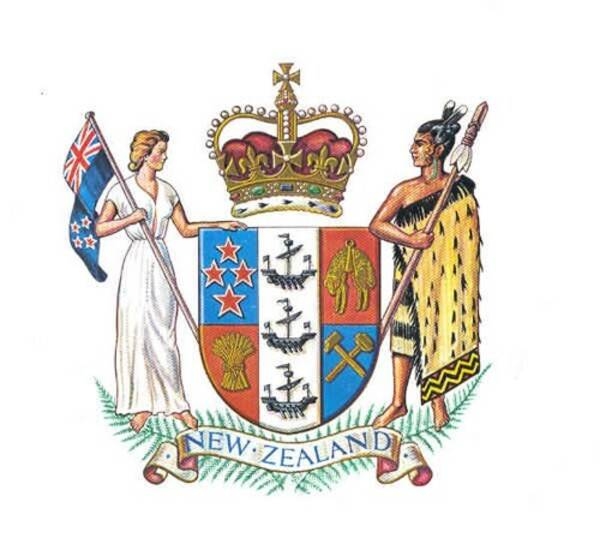
National anthem
name: "God Defend New Zealand"
lyrics/music: Thomas BRACKEN [English], Thomas Henry SMITH [Maori]/John Joseph WOODS
note: adopted 1940 as national song, adopted 1977 as co-national anthem; New Zealand has two national anthems with equal status; as a commonwealth realm, in addition to "God Defend New Zealand," "God Save the King" serves as a royal anthem (see United Kingdom); "God Save the King" normally played only when a member of the royal family or the governor-general is present; in all other cases, "God Defend New Zealand" is played
National heritage
total World Heritage Sites: 3 (2 natural, 1 mixed)
selected World Heritage Site locales: Te Wahipounamu – South West New Zealand (n); Tongariro National Park (m); New Zealand Sub-Antarctic Islands (n)
Economy
Economic overview
Over the past 40 years, the government has transformed New Zealand from an agrarian economy, dependent on concessionary British market access, to a more industrialized, free market economy that can compete globally. This dynamic growth has boosted real incomes, but left behind some at the bottom of the ladder and broadened and deepened the technological capabilities of the industrial sector.
Per capita income rose for 10 consecutive years until 2007 in purchasing power parity terms, but fell in 2008-09. Debt-driven consumer spending drove robust growth in the first half of the decade, fueling a large balance of payments deficit that posed a challenge for policymakers. Inflationary pressures caused the central bank to raise its key rate steadily from January 2004 until it was among the highest in the OECD in 2007 and 2008. The higher rate attracted international capital inflows, which strengthened the currency and housing market while aggravating the current account deficit. Rising house prices, especially in Auckland, have become a political issue in recent years, as well as a policy challenge in 2016 and 2017, as the ability to afford housing has declined for many.
Expanding New Zealand’s network of free trade agreements remains a top foreign policy priority. New Zealand was an early promoter of the Trans-Pacific Partnership (TPP) and was the second country to ratify the agreement in May 2017. Following the United States’ withdrawal from the TPP in January 2017, on 10 November 2017 the remaining 11 countries agreed on the core elements of a modified agreement, which they renamed the Comprehensive and Progressive Agreement for Trans-Pacific Partnership (CPTPP). In November 2016, New Zealand opened negotiations to upgrade its FTA with China; China is one of New Zealand’s most important trading partners.
Real GDP (purchasing power parity)
$215.6 billion (2020 est.)
$213.5 billion (2019 est.)
$210.07 billion (2018 est.)
note: data are in 2017 dollars
Real GDP growth rate
2.22% (2019 est.)
3.22% (2018 est.)
3.8% (2017 est.)
Real GDP per capita
$42,400 (2020 est.)
$42,900 (2019 est.)
$42,900 (2018 est.)
note: data are in 2017 dollars
GDP (official exchange rate)
$205.202 billion (2019 est.)
Inflation rate (consumer prices)
1.6% (2019 est.)
1.5% (2018 est.)
1.8% (2017 est.)
Credit ratings
Fitch rating: AA (2011)
Moody's rating: Aaa (2002)
Standard & Poors rating: AA (2011)
note: The year refers to the year in which the current credit rating was first obtained.
GDP - composition, by sector of origin
agriculture: 5.7% (2017 est.)
industry: 21.5% (2017 est.)
services: 72.8% (2017 est.)
GDP - composition, by end use
household consumption: 57.2% (2017 est.)
government consumption: 18.2% (2017 est.)
investment in fixed capital: 23.4% (2017 est.)
investment in inventories: 0.3% (2017 est.)
exports of goods and services: 27% (2017 est.)
imports of goods and services: -26.1% (2017 est.)
Agricultural products
milk, beef, kiwi fruit, apples, potatoes, mutton, grapes, wheat, barley, green onions/shallots
Industries
agriculture, forestry, fishing, logs and wood articles, manufacturing, mining, construction, financial services, real estate services, tourism
Labor force - by occupation
agriculture: 6.6%
industry: 20.7%
services: 72.7% (2017 est.)
Youth unemployment rate (ages 15-24)
total: 10.5%
male: 10.8%
female: 10.2% (2021 est.)
Gini Index coefficient - distribution of family income
36.2 (1997)
country comparison to the world: 92Household income or consumption by percentage share
lowest 10%: NA
highest 10%: NA
Budget
revenues: 74.11 billion (2017 est.)
expenditures: 70.97 billion (2017 est.)
Fiscal year
1 April - 31 March
note: this is the fiscal year for tax purposes
Current account balance
-$6.962 billion (2019 est.)
-$8.742 billion (2018 est.)
Exports
$50.43 billion (2020 est.) note: data are in current year dollars
$57.16 billion (2019 est.) note: data are in current year dollars
$57.71 billion (2018 est.) note: data are in current year dollars
Exports - partners
China 28%, Australia 14%, United States 9%, Japan 6% (2019)
Exports - commodities
dairy products, sheep/goat meats, lumber, beef products, fresh fruits (2019)
Imports
$47.86 billion (2020 est.) note: data are in current year dollars
$57.75 billion (2019 est.) note: data are in current year dollars
$58.39 billion (2018 est.) note: data are in current year dollars
Imports - partners
China 18%, Australia 15%, United States 9%, Japan 6%, Germany 5% (2019)
Imports - commodities
cars, crude petroleum, refined petroleum, delivery trucks, gas turbines (2019)
Reserves of foreign exchange and gold
$20.68 billion (31 December 2017 est.)
$17.81 billion (31 December 2016 est.)
Debt - external
$190.621 billion (2019 est.)
$192.327 billion (2018 est.)
Exchange rates
New Zealand dollars (NZD) per US dollar -
1.41794 (2020 est.)
1.52334 (2019 est.)
1.45709 (2018 est.)
1.4279 (2014 est.)
1.2039 (2013 est.)
Energy
Electricity access
electrification - total population: 100% (2020)
Electricity
installed generating capacity: 9.615 million kW (2020 est.)
consumption: 41,169,838,000 kWh (2019 est.)
exports: 0 kWh (2020 est.)
imports: 0 kWh (2020 est.)
transmission/distribution losses: 2,256,332,000 kWh (2019 est.)
Electricity generation sources
fossil fuels: 19.5% of total installed capacity (2020 est.)
nuclear: 0% of total installed capacity (2020 est.)
solar: 0.4% of total installed capacity (2020 est.)
wind: 5.3% of total installed capacity (2020 est.)
hydroelectricity: 54.8% of total installed capacity (2020 est.)
tide and wave: 0.1% of total installed capacity (2020 est.)
geothermal: 18.6% of total installed capacity (2020 est.)
biomass and waste: 1.4% of total installed capacity (2020 est.)
Coal
production: 3.226 million metric tons (2020 est.)
consumption: 3.001 million metric tons (2020 est.)
exports: 1.14 million metric tons (2020 est.)
imports: 1.09 million metric tons (2020 est.)
proven reserves: 7.575 billion metric tons (2019 est.)
Petroleum
total petroleum production: 13,400 bbl/day (2021 est.)
refined petroleum consumption: 184,600 bbl/day (2019 est.)
crude oil and lease condensate exports: 21,600 bbl/day (2018 est.)
crude oil and lease condensate imports: 99,900 bbl/day (2018 est.)
crude oil estimated reserves: 41 million barrels (2021 est.)
Refined petroleum products - production
115,100 bbl/day (2017 est.)
country comparison to the world: 65Natural gas
production: 4,771,126,000 cubic meters (2019 est.)
consumption: 4,946,237,000 cubic meters (2019 est.)
exports: 0 cubic meters (2021 est.)
imports: 0 cubic meters (2021 est.)
proven reserves: 31.148 billion cubic meters (2021 est.)
Carbon dioxide emissions
40.344 million metric tonnes of CO2 (2019 est.)
from coal and metallurgical coke: 5.139 million metric tonnes of CO2 (2019 est.)
from petroleum and other liquids: 25.76 million metric tonnes of CO2 (2019 est.)
from consumed natural gas: 9.445 million metric tonnes of CO2 (2019 est.)
Energy consumption per capita
186.804 million Btu/person (2019 est.)
country comparison to the world: 22Communications
Telephones - fixed lines
total subscriptions: 858,000 (2020 est.)
subscriptions per 100 inhabitants: 18 (2020 est.)
Telephones - mobile cellular
total subscriptions: 6.148 million (2020 est.)
subscriptions per 100 inhabitants: 127 (2020 est.)
Telecommunication systems
general assessment: the principal growth areas in in New Zealand’s telecom market have been in mobile broadband and fiber; the UFB1 rollout was completed in November 2019 and the UFB2 rollout is scheduled to be completed by the end of 2022; Chorus noted that as of the beginning of 2022, 1Gb/s plans accounted for about 23% of all fiber connections, while 43% of business customers adopted a gigabit service; New Zealand’s mobile market continues to undergo significant developments; there have been considerable gains made in LTE services, with effective competition between Spark, Vodafone NZ, and 2degrees; the widening coverage of LTE networks has been supported by the Rural Broadband Initiative rollout, which added a significant number of mobile sites to new or underserved areas; as the initiative is winding down, this has enabled the participating telcos to invest in NB-IoT and other platforms; Vodafone NZ expects to extend its NB-IoT footprint to cover at least 60% of the country by 2024; the market is undergoing additional consolidation, with approval of the merger between 2degrees and Orcon Group having been granted by regulators in May 2022; this will create the country’s third-largest integrated telco, offering fixed and mobile services in competition with Spark and Vodafone NZ. The merger proposal came fast of the heels of Vocus Group and its local subsidiary Orcon having acquired 2degrees from Trilogy International in December 2021; this deal created a new company, Voyage Digital. (2020)
domestic: fixed-line roughly 18 per 100 and mobile-cellular telephone subscribership 127 per 100 persons (2020)
international: country code - 64; landing points for the Southern Cross NEXT, Aqualink, Nelson-Levin, SCCN and Hawaiki submarine cable system providing links to Australia, Fiji, American Samoa, Kiribati, Samo, Tokelau, US and around New Zealand; satellite earth stations - 8 (1 Inmarsat - Pacific Ocean, 7 other) (2019)
note: the COVID-19 pandemic continues to have a significant impact on production and supply chains globally; since 2020, some aspects of the telecom sector have experienced a downturn, particularly in mobile device production; progress toward 5G implementation has resumed, as well as upgrades to infrastructure; consumer spending on telecom services has increased due to the surge in demand for capacity and bandwidth; the crucial nature of telecom services as a tool for work and school from home is still evident, and the spike in this area has seen growth opportunities for development of new tools and increased services
Broadcast media
state-owned Television New Zealand operates multiple TV networks and state-owned Radio New Zealand operates 3 radio networks and an external shortwave radio service to the South Pacific region; a small number of national commercial TV and radio stations and many regional commercial television and radio stations are available; cable and satellite TV systems are available, as are a range of streaming services (2019)
Internet users
total: 4,677,556 (2020 est.)
percent of population: 92% (2020 est.)
Broadband - fixed subscriptions
total: 1,764,984 (2020 est.)
subscriptions per 100 inhabitants: 37 (2020 est.)
Transportation
National air transport system
number of registered air carriers: 15 (2020)
inventory of registered aircraft operated by air carriers: 199
annual passenger traffic on registered air carriers: 17,249,049 (2018)
annual freight traffic on registered air carriers: 1,349,300,000 (2018) mt-km
Airports - with paved runways
total: 39
over 3,047 m: 2
2,438 to 3,047 m: 1
1,524 to 2,437 m: 12
914 to 1,523 m: 23
under 914 m: 1 (2021)
Airports - with unpaved runways
total: 84
1,524 to 2,437 m: 3
914 to 1,523 m: 33
under 914 m: 48 (2021)
Pipelines
331 km condensate, 2,500 km gas, 172 km liquid petroleum gas, 288 km oil, 198 km refined products (2018)
Railways
total: 4,128 km (2018)
narrow gauge: 4,128 km (2018) 1.067-m gauge (506 km electrified)
Roadways
total: 94,000 km (2017)
paved: 61,600 km (2017) (includes 199 km of expressways)
unpaved: 32,400 km (2017)
Merchant marine
total: 115
by type: container ship 1, general cargo 12, oil tanker 4, other 98 (2021)
Ports and terminals
major seaport(s): Auckland, Lyttelton, Manukau Harbor, Marsden Point, Tauranga, Wellington
Military and Security
Military and security forces
New Zealand Defense Force (NZDF): New Zealand Army, Royal New Zealand Navy, Royal New Zealand Air Force (2022)
Military expenditures
1.4% of GDP (2022 est.)
1.3% of GDP (2021)
1.5% of GDP (2020)
1.4% of GDP (2019) (approximately $3.1 billion)
1.2% of GDP (2018) (approximately $2.62 billion)
Military and security service personnel strengths
approximately 9,500 active-duty troops (4,700 Army; 2,300 Navy; 2,500 Air Force) (2022)
Military equipment inventories and acquisitions
the NZDF is equipped mostly with imported weapons and equipment from Western suppliers; the US has been the leading provider since 2010 (2022)
Military service age and obligation
17 years of age for men and women for voluntary military service; soldiers cannot be deployed until the age of 18; no conscription (2022)
note 1: New Zealand opened up all military occupations to women in 2000; in 2019, women accounted for about 18% of the uniformed full-time personnel
note 2: as of 2022, the NZDF’s program for recruiting foreign volunteers had been suspended
Military deployments
up to 220 Antarctica (summer season only) (2022)
Military - note
New Zealand is a member of the Five Powers Defense Arrangements (FPDA), a series of mutual assistance agreements reached in 1971 embracing Australia, Malaysia, New Zealand, Singapore, and the UK; the FPDA commits the members to consult with one another in the event or threat of an armed attack on any of the members and to mutually decide what measures should be taken, jointly or separately; there is no specific obligation to intervene militarily
New Zealand has been part of the Australia, New Zealand, and US Security (ANZUS) Treaty since 1951; however, the US suspended its ANZUS security obligations to New Zealand in 1986 after New Zealand implemented a policy barring nuclear-armed and nuclear-powered warships from its ports; the US and New Zealand signed the Wellington Declaration in 2010, which reaffirmed close ties between the two countries, and in 2012 signed the Washington Declaration, which provided a framework for future security cooperation and defense dialogues; in 2016, a US naval ship conducted the first bilateral warship visit to New Zealand since the 1980s
New Zealand has Major Non-NATO Ally (MNNA) status with the US; MNNA is a designation under US law that provides foreign partners with certain benefits in the areas of defense trade and security cooperation; while MNNA status provides military and economic privileges, it does not entail any security commitments (2022)
Terrorism
Terrorist group(s)
Islamic State of Iraq and ash-Sham (ISIS)
note: details about the history, aims, leadership, organization, areas of operation, tactics, targets, weapons, size, and sources of support of the group(s) appear(s) in Appendix-T
Transnational Issues
Disputes - international
New Zealand-Antarctica: asserts a territorial claim in Antarctica (Ross Dependency)
Illicit drugs
significant consumer of amphetamines
